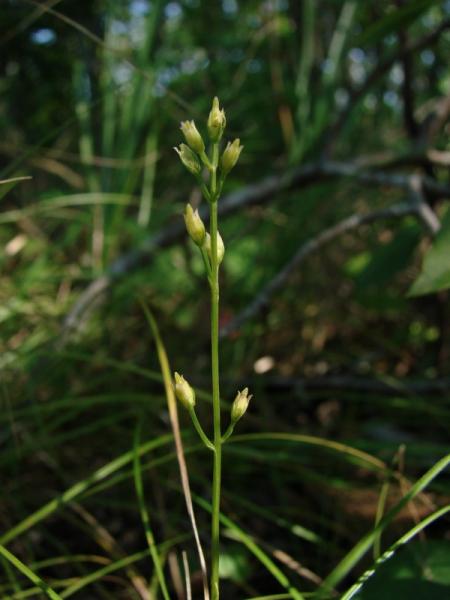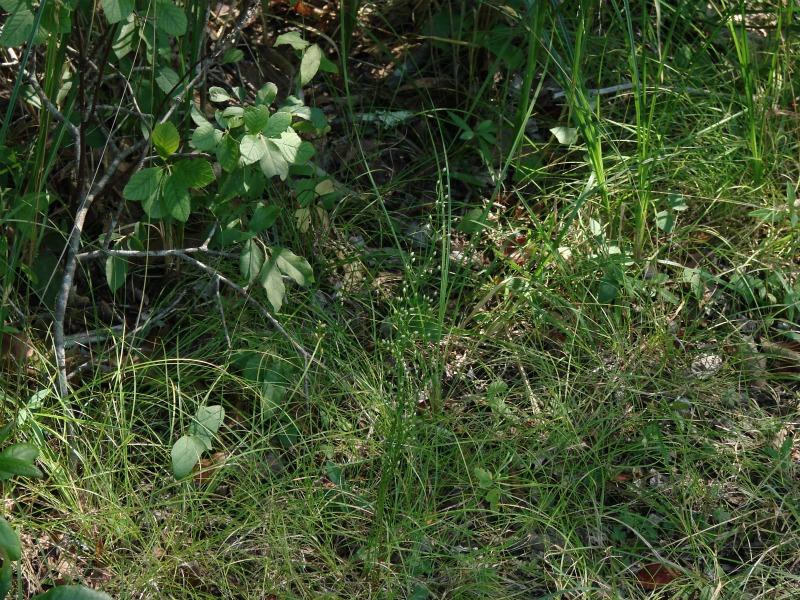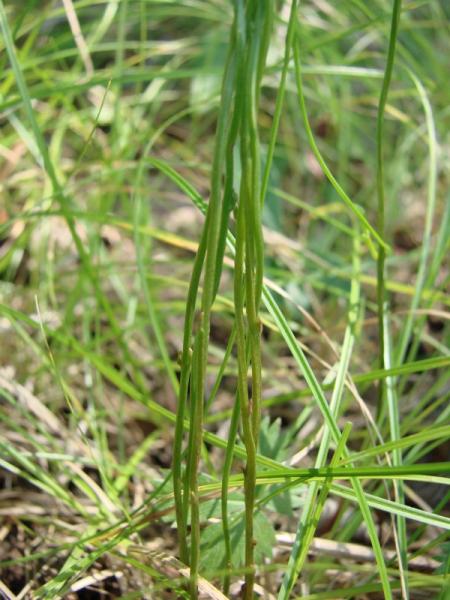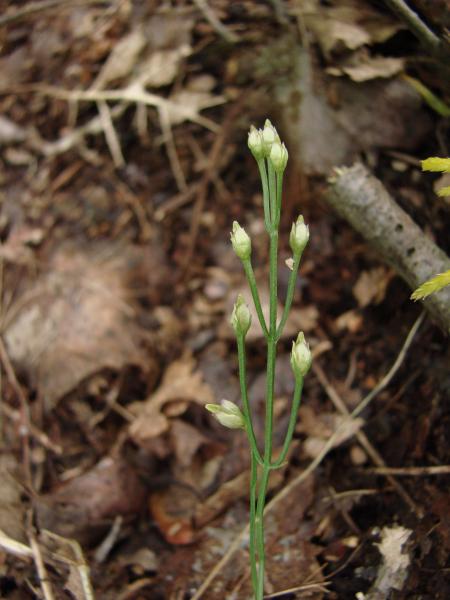Green Screwstem
Bartonia paniculata ssp. paniculata None
- Class
- Dicotyledoneae (Dicots)
- Family
- Gentianaceae (Gentian Family)
- State Protection
- Endangered
Listed as Endangered by New York State: in imminent danger of extirpation in New York. For animals, taking, importation, transportation, or possession is prohibited, except under license or permit. For plants, removal or damage without the consent of the landowner is prohibited.
- Federal Protection
- Not Listed
- State Conservation Status Rank
- S1
Critically Imperiled in New York - Especially vulnerable to disappearing from New York due to extreme rarity or other factors; typically 5 or fewer populations or locations in New York, very few individuals, very restricted range, very few remaining acres (or miles of stream), and/or very steep declines.
- Global Conservation Status Rank
- G5T5
Secure globally - Both the species as a whole and the subspecies/variety are common in the world; widespread and abundant (but may be rare in some parts of its range).
Summary
Did you know?
The genus Bartonia was named for the famous Philadelphia botanist Benjamin Smith Barton by fellow Philadelphia botanist Henry Muhlenberg (Fernald 1950). It is one of only two genera that Muhlenberg named. Both botanists died in 1815, seven months apart (Lee 1999).
State Ranking Justification
There are five known populations but only two of them have exact numbers of plants and they are small. The remaining populations are assumed to be small. There are 20 historical occurrences.
Short-term Trends
There is not enough information on population size and resurveys to know the short-term trend.
Long-term Trends
There are many historical records and only five known populations, so it seems that the long-term trend is downward. This plant is difficult to find so it may be overlooked in the field and more common than we think. More field work is needed to determine the exact scale of the long-term trend.
Conservation and Management
Threats
One population is threatened by ditching of the wetland and a phragmites invasion, and another is threatened by improper mowing of a roadside habitat. Changes in wetland habitat and destruction of wetlands are the biggest threats to the species.
Conservation Strategies and Management Practices
Wetlands should be protected from changes in hydrology and be kept free of invasive species. A buffer should be established around plants to prevent direct human disturbance.
Research Needs
We need to understand the demography and habitat preference of this species. We come across it when exploring wetlands but we don't know why it grows where it does. This would help us narrow down our search areas, especially for historical records.
Habitat
Habitat
In New York, Bartonia paniculata spp. paniculata has been most often collected from coastal wetlands, usually associated with Sphagnum mosses (New York Natural Heritage Program 2010). Most common in level sandy or peaty acidic wetlands along the Atlantic coastal plain (Higman and Penskar 1996). Wet peat and sand (Fernald 1970). Swamps, bogs, and wet meadows (Gleason & Cronquist 1991).
Associated Ecological Communities
- Coastal plain Atlantic white cedar swamp*
(guide)
A swamp that occurs on organic soils along streams and in poorly drained depressions of the coastal plain. Atlantic white cedar makes up over 50% of the canopy cover. In mixed stands in New York, red maple is the codominant tree.
- Coastal plain pond shore*
(guide)
The gently sloping shore of a coastal plain pond with seasonally and annually fluctuating water levels. Plants growing on the pond shore vary with water levels. In dry years when water levels are low there is often a dense growth of annual sedges, grasses, and herbs. Submerged and floating-leaved aquatic plants, such as fragrant waterlily and pondweeds, may become "stranded" on the exposed shore. In wet years when the water level is high only a few emergents and floating-leaved aquatics may be noticeable. T
- Coastal plain stream*
The aquatic community of slow-moving, often darkly-stained streams of the coastal plain of Long Island.
- High salt marsh
(guide)
A coastal marsh community that occurs in sheltered areas of the seacoast, in a zone extending from mean high tide up to the limit of spring tides. It is periodically flooded by spring tides and flood tides. High salt marshes typically consist of a mosaic of patches that are mostly dominated by a single graminoid species.
- Maritime freshwater interdunal swales
(guide)
A mosaic of wetlands that occur in low areas between dunes along the Atlantic coast; the low areas (swales) are formed either by blowouts in the dunes that lower the soil surface to groundwater level, or by the seaward extension of dune fields. Water levels fluctuate seasonally and annually. Sedges and herbs are usually the most abundant types of plants. These wetlands may be quite small (less than 0.25 acre).
- Northern white cedar swamp
(guide)
A swamp that occurs on organic soils in cool, poorly drained depressions in central and northern New York, and along lakes and streams in the northern half of the state. These swamps are often spring-fed with continually saturated soils. Soils are often rich in calcium. The characteristic tree is northern white cedar, which makes up more than 30% of the canopy cover.
- Saltwater tidal creek*
(guide)
The aquatic community of a shallow, tidally flooded saltwater or brackish creek with submerged areas averaging less than 2 m (6 ft) deep at low tide.
* probable association but not confirmed.
Associated Species
- Pogonia ophioglossoides (rose pogonia)
- Rhexia sp.
- Sphagnum sp.
- Thuja occidentalis (northern white cedar, arbor vitae)
Range
New York State Distribution
This small herb is presently known from Suffolk and Westchester Counties. It is considered extirpated on Western Long Island and the New York City area where it was once found.
Global Distribution
This plant is most common in the southeastern and midwestern US, where it ranges from Texas northeast to Michigan and east to the Atlantic. It is rare across the northern part of its range, from Ontario to New York and Maine.
Identification Comments
General Description
Screw-stem is a small vascular plant, about 10 to 40 cm tall, with greenish-yellow or purplish, often twisted or spiralling stems. The leaves are alternate and reduced to minute scales. The flowers are a mere 2.5 to 4 mm long, with 4 lance-shaped white petals.
Best Life Stage for Proper Identification
Flowering or fruiting stems are more likely to make this inconspicuous plant noticeable, but the plants may be identified from stems with leaves.
Similar Species
Bartonia virginica has more strongly erect stems, opposite leaf scales, and merely lobed (not deeply cleft as in B. paniculata ssp. paniculata) sepals.
Best Time to See
Screw-stem flowers from August through mid-September, and the fruits persist until the end of October.
- Flowering
- Fruiting
The time of year you would expect to find Green Screwstem flowering and fruiting in New York.
Green Screwstem Images
Images of Similar Species
Taxonomy
Green Screwstem
Bartonia paniculata ssp. paniculata None
- Kingdom Plantae
- Phylum Anthophyta
- Class Dicotyledoneae
(Dicots)
- Order Gentianales
- Family Gentianaceae (Gentian Family)
- Order Gentianales
- Class Dicotyledoneae
(Dicots)
- Phylum Anthophyta
Additional Common Names
- Screw-stem
Synonyms
- Bartonia iodandra B.L. Robins. [Possibly misapplied to New York specimen. This specimens need to be tracked down to determine if they really are ssp. iodandra or ssp. paniculata.]
- Bartonia paniculata ssp. paniculata
- Bartonia paniculata var. intermedia Fern.
- Bartonia paniculata var. paniculata
Additional Resources
References
Gleason, Henry A. and A. Cronquist. 1991. Manual of Vascular Plants of Northeastern United States and Adjacent Canada. The New York Botanical Garden, Bronx, New York. 910 pp.
Holmgren, Noel. 1998. The Illustrated Companion to Gleason and Cronquist's Manual. Illustrations of the Vascular Plants of Northeastern United States and Adjacent Canada. The New York Botanical Garden, Bronx, New York.
Mitchell, Richard S. 1986. A checklist of New York State plants. Bulletin No. 458. New York State Museum. 272 pp.
New York Natural Heritage Program. 2010. Biotics database. New York Natural Heritage Program. New York State Department of Environmental Conservation. Albany, NY.
New York Natural Heritage Program. 2024. New York Natural Heritage Program Databases. Albany, NY.
Smith, C. Earle Jr. 1962. Henry Muhlenberg-botanical pioneer. Proceedings of the American Philosophical Society, vol. 106, no. 5 (Oct. 11, 1962), pp. 443-460.
Weldy, T. and D. Werier. 2010. New York flora atlas. [S.M. Landry, K.N. Campbell, and L.D. Mabe (original application development), Florida Center for Community Design and Research http://www.fccdr.usf.edu/. University of South Florida http://www.usf.edu/]. New York Flora Association http://newyork.plantatlas.usf.edu/, Albany, New York
Links
About This Guide
Information for this guide was last updated on: February 23, 2011
Please cite this page as:
New York Natural Heritage Program. 2024.
Online Conservation Guide for
Bartonia paniculata ssp. paniculata.
Available from: https://guides.nynhp.org/screw-stem/.
Accessed July 27, 2024.




